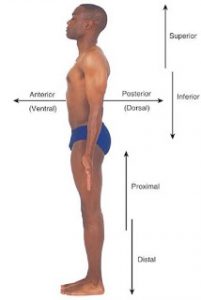In the course of any given shift at work, CNA’s come across words and abbreviations and diseases and conditions we have never heard of before. There are hundreds of terms to learn. In this article we hope to make this task a little easier.
First off, scan this list of common medical abbreviations. We use them with charting. We read them in the medical histories sections of patient charts. Do we understand what they all mean?
Abbreviations are well known in our work; each facility should have it’s own list of accepted abbreviationsused in charting/orders. Without such a list, staff can use many different abbreviations, which are accepted but perhaps mean something else to each member of the team. Confusion can arise and patients can be harmed by misunderstandings.
Some terms we read are based on the human body. Terms associated with certain sections of the body are called descriptive terms.
All references to the body are made in relationship to the anatomical position. This refers to the standing forward facing body. A imaginary line is drawn down the center from head to feet which divides the body into two equal halves.
When we read the word MEDIAL it means the part is closer to to the line/center; LATERAL mean further from the line/center.
Your thumbs are more lateral than your pinky finger…
Imagine another line being drawn- this one dividing the upper and lower body into two halves. The line is right under the navel. When we read the term SUPERIOR it refers to above the line; INFERIOR means below the line.
Further, turn the body to face sideways. A line is drawn down the center, again. We’ll see terms called ANTERIOR, which means VENTRAL, towards the front. We’ll also see terms referring to POSTERIOR, or DORSAL, which mean toward the back.
Abbreviations are well known in our work; each facility should have it’s own list of accepted abbreviationsused in charting/orders. Without such a list, staff can use many different abbreviations, which are accepted but perhaps mean something else to each member of the team. Confusion can arise and patients can be harmed by misunderstandings.
Some terms we read are based on the human body. Terms associated with certain sections of the body are called descriptive terms.
All references to the body are made in relationship to the anatomical position. This refers to the standing forward facing body. A imaginary line is drawn down the center from head to feet which divides the body into two equal halves.
When we read the word MEDIAL it means the part is closer to to the line/center; LATERAL mean further from the line/center.
Your thumbs are more lateral than your pinky finger…
Imagine another line being drawn- this one dividing the upper and lower body into two halves. The line is right under the navel. When we read the term SUPERIOR it refers to above the line; INFERIOR means below the line.
Further, turn the body to face sideways. A line is drawn down the center, again. We’ll see terms called ANTERIOR, which means VENTRAL, towards the front. We’ll also see terms referring to POSTERIOR, or DORSAL, which mean toward the back.
The human abdomen is also divided into four sections, called quadrants. In your work you’re apt to read notes using these terms:
RUQ= Right upper quadrant
RLQ= Right lower quadrant
LUQ = Left upper quadrant
LLQ = Left lower quadrant
It’s pretty self explanatory where these sections are located.
There are many other forms of medical jargon to decipher. Understanding word roots, prefixes and suffixes can help this process a lot.
A word root is the foundation of a medical term.Word roots usually (not always) refer to the body part being described.
A prefix is added to the beginning of the word to change or add to it’s meaning
A suffix is added to the end of the word to change or add to it’s meaning.
Some examples of root words:
aden= gland
bronch=bronchi
chol=bile
crani=skull
dent=tooth
hem=blood
hepat=liver
hyster=uterus
my=muscle
nephr=kidney
pulm=lung
ur=urine
Some common Prefixes and sample meanings:
a=without (AFebrile or without fever)
brady=SLOW (Bradycardia or slow pulse rate)
dys=PAIN, DIFFICULTY (Dysuria or painful urination)
hyper=ABOVE, EXCESSIVE (High blood pressure or hyper tension, Hypothermia or high body temperature)
hypo=LOW, DEFICIENT (Low blood pressure or HYPO tension; HYPOthermia or low body temp)
pan= PANDEMIC (flu, Black Plague)
poly= MANY (polyuria or excessive urine)
post= AFTER (Post Operation, Post seizure)
pre=before, prior (Pre menstrual)
tachy= FAST (TACHYbradia or high pulse rate)
What medical terms can you associate with the above prefixes?
Some common suffixes:
ectomy= REMOVAL (hysterectomy)
itis=INFLAMMATION (bronchitis)
gram=RECORD (electrocardiogram)
emia=BLOOD (Anemia)
logy=STUDY OF (oncology)
oma=TUMOR (Fibroma)
otomy=INCISION (tracheotomy)
plegia=paralysis (Hemiplegia)
pnea=RESPIRATIONS (apnea)
scope=EXAM INSTRUMENT (stethoscope, otoscope)
scopy=EXAM USING A SCOPE (endoscopy)
What other medical terms can you associate with the above suffixes?
For a much more comprehensive resource for medical terms and descriptions, go to THIS SITE.
This resource also lists frequently used medical terms.
THIS SITE has an excellent graphics and descriptions of human anatomy.
HERE You’ll find a detailed list of anatomical terms frequently used.

